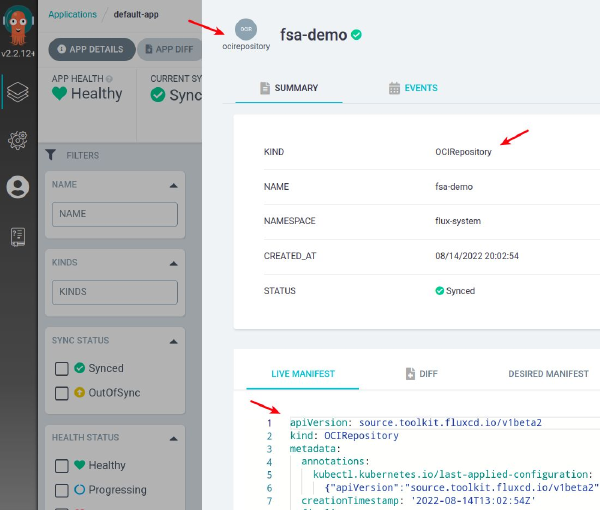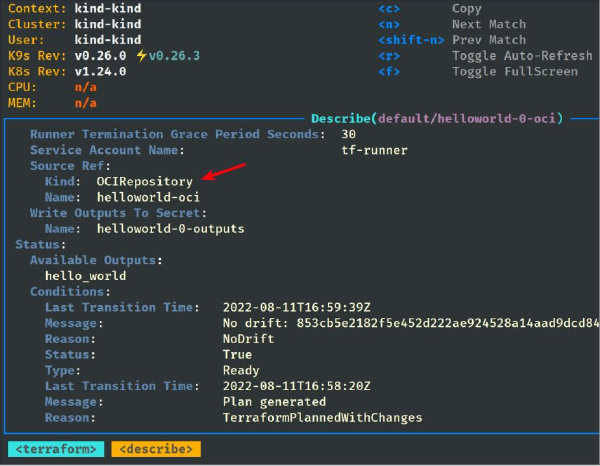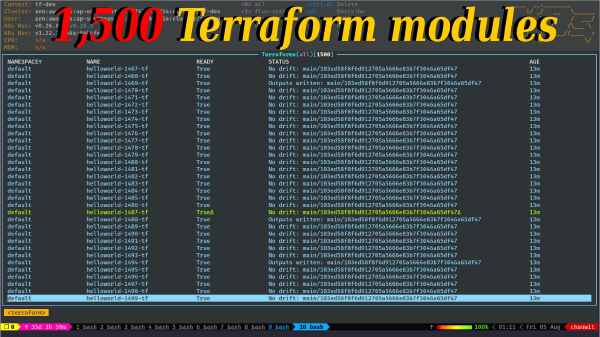You are viewing documentation for Flux version: 2.2
Version 2.2 of the documentation is no longer actively maintained. The site that you are currently viewing is an archived snapshot. For up-to-date documentation, see the latest version.
This article is more than one year old. Older articles may contain outdated content. Check that the information in the page has not become incorrect since its publication.
August 2022 Update
As the Flux family of projects and its communities are growing, we strive to inform you each month about what has already landed, new possibilities which are available for integration, and where you can get involved. Read our last update here.
It’s the beginning of September 2022 - let’s recap together what happened in August - it has been a lot!
News in the Flux family
New Flux releases add OCI support and better integration with cloud services
August saw two big releases of Flux: v0.33 and v0.32. Let’s go through the major changes one by one.
- Enable contextual login to container registries when pulling Helm
charts from Amazon Elastic Container Registry, Azure Container
Registry and Google Artifact Registry using
HelmRepository.spec.provider. - Select which layer contains the Kubernetes configs by specifying a
matching OCI media type using
OCIRepository.spec.layerSelector. - Authenticate to Azure Blob storage with SAS tokens using
Bucket.spec.secretRef. - Allow filtering OCI artifacts by semver and regex when listing
artifact with
flux list artifacts. - Allow excluding local files and directories when building and
publishing artifacts with
flux push artifact. - New Flux CLI commands
flux push|pull|tagartifact for publishing OCI Artifacts to container registries. - New source type
OCIRepositoryfor fetching OCI artifacts from container registries. - Resolve Helm dependencies from OCI for charts defined in Git.
The big news was of course that we added support for distributing Kubernetes manifests, Kustomize overlays and Terraform code as OCI artifacts. For more information on OCI support please see the Flux documentation.
Big thanks to the Flux contributors that helped us along the way. It took us almost 4 months, from the first RFC version to shipping OCI support today. And a special thanks to Rashed and the whole VMware Tanzu team for the excellent collaboration!
No more pesky secrets to authenticate against Azure, AWS and GCP container registries when deploying Helm charts with @fluxcd. Starting with v0.33, Flux leverages #Kubernetes workload identity and IAM when pulling OCI artifacts from managed registries. https://t.co/V9dbT6orrP pic.twitter.com/N7EB4D0Is8
— Stefan Prodan (@stefanprodan) August 31, 2022
I'm super excited to announce that @fluxcd support for distributing #Kubernetes manifests, Kustomize overlays and Terraform code as OCI artifacts has finally shipped in v0.32. https://t.co/144HY6LUTy
— Stefan Prodan (@stefanprodan) August 11, 2022
Security news
We are continuously putting effort into the security story of Flux. One cornerstone of this is fuzzing of all code. As promised, we started transitioning our fuzz tests to the native Go implementation.
We are happy to say that we managed to contribute back to Google’s
oss-fuzz improving Go Native Fuzz implementation as well during this
effort (
patch
1,
patch
2).
Flagger 1.22.2
Flagger 1.22.2 received a patch release as well during August. It fixes a bug related to scaling up the canary deployment when a reference to an auto-scaler is specified.
Furthermore, it contains updates to packages used by the project, including updates to Helm and grpc-health-probe used in the load-tester.
A number of CVEs originating from its dependencies were fixed as well.
Flux Ecosystem
Flux Subsystem for Argo
Flux added OCIRepository as a new kind of Source in its recent release.
The new version of
Flux Subsystem for Argo
(FSA) brings these good bits
of Flux to Argo CD. The team has also recently upgraded FSA to Argo CD
v2.2.12 to contain recent security bug fixes again. This version of Flux
Subsystem for Argo requires Flux v0.32.0 to install.

Terraform-controller
The team has released
TF-controller
v0.11
which now supports Flux OCIRepository. To use Flux OCIRepository with
TF-controller, you’re required to upgrade Flux to v0.32+.

In addition to the new OCIRepository support, the TF-controller team is
glad to announce that the performance of TF-controller has been improved
significantly. Now the controller is greatly scalable to reconcile and
provision high volumes of Terraform modules concurrently. The team has
recently tested the controller with 1,500 Terraform modules.

Weave GitOps
The team at Weaveworks is continuing to invest in Applications first! They’ve focused this quarter on building and improving the primitives that make up Weave GitOps. Their aim is to make it easy for platform operators to simplify adoption of Kubernetes and Cloud Native in general across their engineering organization. An easy to use platform that is extensible and safe for organizations to meet their needs.
The OSS team released
v0.9.4.
There are a lot of iterative improvements in the app such as the ability to
pause and resume multiple sources or automation objects from the UI. In
addition, there are a bunch of tiny UI and visual improvements. Getting
started is now simpler due to a new gitops create dashboard command for
producing the HelmRelease and HelmRepository objects. Plus, some
foundational improvements for gitops run.
On the enterprise side they are wrapping up workspaces including the GUI, that gives you a single pane of glass what applications and policies belong to which tenant! That makes governance for Platform teams easy and enables Application teams to operate efficiently in safe boundaries. In addition, they have a new add application experience that makes it easy to use Kustomizations and Helm Charts via their UI. Now you have a single simple flow to add your workloads/applications independently if it’s k8s manifest in a Git Repository or Helm Charts. Look for an upcoming release (v0.9.4) in the next week for these two items.
VS Code GitOps Extension
Anyone who loves the GitOps Extension for VS Code should update to the latest version. Among other things it just received a number of security fixes. Find the relevant details on its advisories page.
Recent & Upcoming Events
It’s important to keep you up to date with new features and developments in Flux and provide simple ways to see our work in action and chat with our engineers.
Recent Events (ICYMI) 📺
We feel blessed to have such a big community of users, contributors and integrators and so many are happy to talk about their experiences. In August here are a couple of talks we would like to highlight.
CNCF Livestream with Kingdon Barrett: VSCode and Flux: Testing the new OCI Repository feature
The Flux project continues in active development with the addition of OCI configuration planned in the GA roadmap. Another Flux advancement has been the creation of the new VSCode Extension which provides a convenient interface to Flux that can help reduce friction moving between editor and terminal, alleviating the headache of context switching overloading developer focus. Flux maintainer Kingdon Barrett demonstrates Flux’s new OCI features and a convenient way to access them.
Upcoming Events 📆
We are happy to announce that we have a number of events coming up in September - tune in to learn more about Flux and GitOps best practices, get to know the team and join our community.
- Sep 15 CNCF on-demand webinar: Flux Increased Security &
Scalability with
OCI
Flux is trusted for its high levels of security, and new OCI support brings even greater GitOps security and scalability. Max will cover the benefits like more streamlined repo structure options and better ways to manage breaking changes in your app.
- Sep 29 CNCF on-demand webinar: How to GitOps Your
Terraform
Pinky will walk you through step-by-step how to manage Terraform resources the GitOps way, from provisioning to enforcement. Bring GitOps to infrastructure and application resources for hybrid automation, state enforcement, drift detection and more.
Flux Bug Scrub
Our Flux Bug Scrubs still are happening on a weekly basis and remain one of the best ways to get involved in Flux. They are a friendly and welcoming way to learn more about contributing and how Flux is organised as a project.
The next dates are going to be:
We are flexible with subjects and often go with the interests of the group or of the presenter. If you want to come and join us in either capacity, just show up or if you have questions, reach out to Kingdon on Slack.
We really enjoyed this demo of the k3d git server recently. It’s a local Git server that runs outside of Kubernetes, to support offline dev in a realistic but also simple way that does not depend on GitHub or other hosted services.
In other news
News from the Website and our Docs
Flux Adopters shout-out
We are very pleased to announce that the following adopters of Flux have come forward and added themselves to our website: Embark Studios and NexHealth.
If you have not already done so, use the instructions here or give us a ping and we will help to add you. Not only is it great for us to get to know and welcome you to our community. It also gives the team a big boost in morale to know where in the world Flux is used everywhere.
More docs and website news
We are constantly improving our documentation and website - here are a couple of small things we landed recently:
- New security docs on Secrets Management and Contextual Authorization.
- New blog post: Managing Kyverno Policies as OCI Artifacts with OCIRepository Sources
- Cheatsheet news
- Flux’s Work Well With section: find out how to make Flux work with your favourite other OSS software
- Lots of new videos from GitOpsCon / KubeCon on our resources page
- Various updates to the Flux Roadmap to indicate what needs to be done for the Flux GA release
- Move to a
fluxcd.io/<project>kind of structure. Add a project picker in the main navbar. Updates of Flux Legacy docs to 1.4.4, Flagger docs to 1.22.2. - Updates of Docsy theme and dependencies. Prevent click-jacking of the site.
Thanks a lot to these folks who contributed to docs and website: Stefan Prodan, Paulo Gomes, Arhell, Kingdon Barrett, Max Jonas Werner, Santosh Kaluskar, David Harris, Sunny, Aurel Canciu, Benny and annaken.
New Flux Project Member: Leigh Capili

We are proud to announce a new project member in the Flux project. Leigh Capili, Staff Developer Advocate at VMware, has been contributing to Flux for a long time already. If you check out his application, he has left a trail of fixes and improvements across almost all of our projects.
What we would like to specifically call out as well, is the countless talks he has done about Flux and GitOps. Take a look at the Flux Resources page to learn more. Three of our current favourites are:
- Securing GitOps Debug Access with Flux, Pinniped, Dex & GitHub
- GitOps with VMware Tanzu Application Platform VMware - Ben Hale & Leigh Capili
- Building Flux's Multi-Tenant API with K8s User Impersonation
Be like Leigh: If you have contributed to Flux and are interested in joining the Flux project as a member, please take a look at our governance documentation for this.
Flux Project Facts
We are very proud of what we have put together. We want to reiterate some Flux facts - they are sort of our mission statement with Flux.
- 🤝 Flux provides GitOps for both apps or infrastructure. Flux and Flagger deploy apps with canaries, feature flags, and A/B rollouts. Flux can also manage any Kubernetes resource. Infrastructure and workload dependency management is built-in.
- 🤖 Just push to Git and Flux does the rest. Flux enables application deployment (CD) and (with the help of Flagger) progressive delivery (PD) through automatic reconciliation. Flux can even push back to Git for you with automated container image updates to Git (image scanning and patching).
- 🔩 Flux works with your existing tools: Flux works with your Git providers (GitHub, GitLab, Bitbucket, can even use s3-compatible buckets as a source), all major container registries, and all CI workflow providers.
- 🔒 Flux is designed with security in mind: Pull vs. Push, least amount of privileges, adherence to Kubernetes security policies and tight integration with security tools and best-practices. Read more about our security considerations.
- ☸️ Flux works with any Kubernetes and all common Kubernetes tooling: Kustomize, Helm, RBAC, and policy-driven validation (OPA, Kyverno, admission controllers) so it simply falls into place.
- 🤹 Flux does Multi-Tenancy (and “Multi-everything”): Flux uses true Kubernetes RBAC via impersonation and supports multiple Git repositories. Multi-cluster infrastructure and apps work out of the box with Cluster API: Flux can use one Kubernetes cluster to manage apps in either the same or other clusters, spin up additional clusters themselves, and manage clusters including lifecycle and fleets.
- 📞 Flux alerts and notifies: Flux provides health assessments, alerting to external systems and external events handling. Just “git push”, and get notified on Slack and other chat systems.
- 👍 Users trust Flux: Flux is a CNCF Incubating project and was categorised as "Adopt" on the CNCF CI/CD Tech Radar (alongside Helm).
- 💖 Flux has a lovely community that is very easy to work with! We welcome contributors of any kind. The components of Flux are on Kubernetes core controller-runtime, so anyone can contribute and its functionality can be extended very easily.
Over and out
If you like what you read and would like to get involved, here are a few good ways to do that:
- Join our upcoming dev meetings on 2022-09-08 or 2022-09-14.
- Talk to us in the #flux channel on CNCF Slack
- Join the planning discussions
- And if you are completely new to Flux, take a look at our Get Started guide and give us feedback
- Social media: Follow Flux on Twitter, join the discussion in the Flux LinkedIn group.
We are looking forward to working with you.